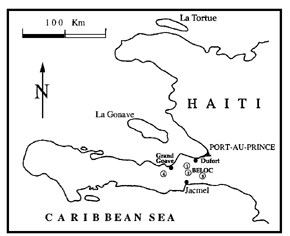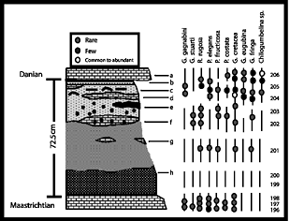|
Evidence of physical disruptions caused by the postulated bolide impact [1] at the close of the Maastrichtian is clearly defined in the record of the K/T boundary (KTB) layer from different sites (Fig. 1) in the Southern Peninsula of Haiti [2,3]. Lithologic and biostratigraphic record [4, 5] of the KTB layer from the different sites also shows varying degrees of mixing, yielding faunal components within a time range consistent with bioevents characteristic of the traditional boundary zone, namely the uppermost part of the Abathomphalus mayaroensis Zone, part of the Guembelitria cretacea Zone, and the Parvularugoglobigerina eugubina Zone, respectively (Fig. 2). The nanno floras also show transitional taxa that concur with the foraminiferal data, and are indicative of the Micula murus and M. prinsii Zones as well as the CP1 of the Early Paleocene. [5]. The Boundary layer shows variation in thickness with a maximum of 75cm at the Beloc stratotype [4], and the topmost part of the main tektite layer is coincident with an iridium peak (Fig. 3). Geochemical analyses [6, 7, 8, and others] also demonstrated the tektite nature of the spherules, which can be chronologically related to the impact event recorded at Chicxulub, Yucatan, Mexico, 65 million years ago [6,8]. Faint primary sedimentary structures within the boundary layer are constant at all outcrops, although discrete spatial differences exist even within short distances (Fig. 4). In the areas adjacent to the stratotype (Platon Piton and Madame Toussaint) a volcanogenic layer occurs below the main tektite layer, which has been assigned to the Chicxulub event [1], and shows conspicuous, as well as cryptic, cross-lamination indicative of complex, multiphase subaqueous flow processes that affected sedimentation of the layers. |
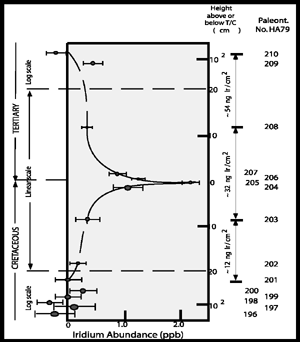 Figure 3. Iridium peak at the K/T boundary. Note position of sample 205 (maximum Ir) located at top of boundary layer in Fig. 2. |
At Platon Piton, the KTB layer consists predominately of tektites, and conforms to the main boundary layer. However, a 65 cm-thick, olive gray (5Y 5/1), volcanogenic layer occurs 7 meters below the KTB horizon. It includes a mixed foraminiferal assemblage indicative of the Latest Maastrichtian. Scarce radiolarian, Archaeodictyomitra lamellicostata, Amphipyndax pseudoconulus, Dictyomitra multicostata, Dictyomitra aff. koslovae, Cryptamphorella aff. conara, also indicate mixing of Campanian to Maastrichtian taxa. The internal fabric of the layer shows anisotropic distribution of the clasts supported by 2 to 30 % matrix similar to the altered tektite layer. Dominant minerals are ilmenite, and mostly dark green euhedral hornblende crystals and fragments, which constitute up to 42 % of the coarse residues; their composition and textural appearance are similar to amphibole phenocrysts found in andesites. Plagioclases make up 15 % of the coarse fraction, and their composition is within the range of plagioclases found in mafic and intermediate igneous rocks. |
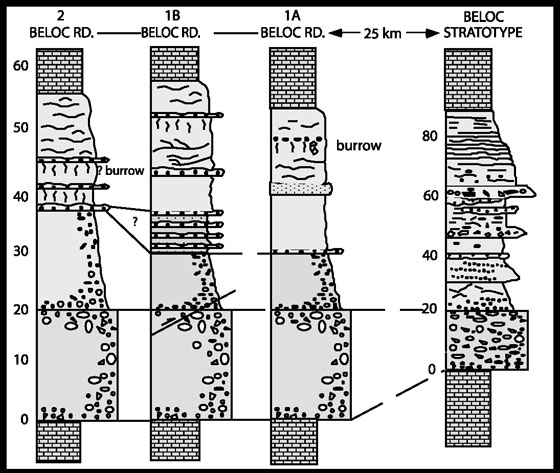 Figure 4. Lateral variation in boundary beds as they occur at localities 1-2 shown in Fig. 1. |
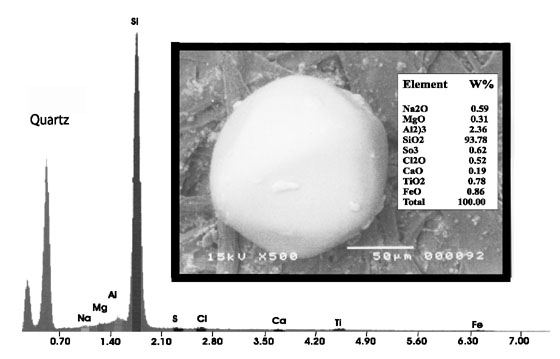 Figure 5. Sub-spherical bi-pyramidal quartz crystal found associated with the volcanogenic layer. Geochemical composition is shown in insert, and SEM analytical results are shown in juxtaposition. |
